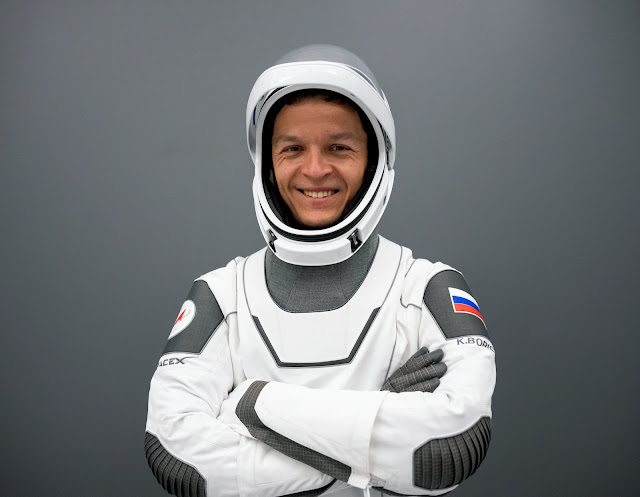Russia's Borisov & Japan's Furukawa of NASA's SpaceX Crew-7
Cosmonaut Konstantin Borisov of Roscosmos (Russia), mission specialist of NASA's SpaceX Crew-7 mission, is pictured in his pressure suit during a crew equipment integration test at SpaceX headquarters in Hawthorne, California.
Japan Aerospace Exploration Agency (JAXA) astronaut Satoshi Furukawa, mission specialist of NASA's SpaceX Crew-7 mission, is pictured in his pressure suit during a crew equipment integration test at SpaceX headquarters in Hawthorne, California.
These are portraits and views of cosmonaut Konstantin Borisov of Roscosmos (Russia) and astronaut Satoshi Furukawa from the Japan Aerospace Exploration Agency (JAXA) during a crew equipment integration test at SpaceX headquarters in Hawthorne, California. Borisov and Furukawa will serve as mission specialists for NASA’s SpaceX Crew-7 mission—the agency’s seventh rotational mission to the International Space Station.
Borisov and Furukawa will join NASA astronaut Jasmin Moghbeli (Crew-7 commander) and European Space Agency (ESA) astronaut Andreas Mogensen of Denmark (pilot).
Furukawa spent 165 days aboard the orbiting laboratory in 2011 as a flight engineer with Expeditions 28 and 29. As part of his duties, he helped support the final space shuttle mission, STS-135.
Astronaut Satoshi Furukawa JAXA Biography:
https://humans-in-space.jaxa.jp/en/astronaut/furukawa-satoshi/
Cosmonaut Konstantin Borisov of Roscosmos will be making his first trip to space, and will also serve as a mission specialist, working to monitor the spacecraft during the dynamic launch and entry phases of flight. He entered the Roscosmos Cosmonaut Corps as a test cosmonaut candidate in 2018 and will serve as a flight engineer for Expedition 69/70.
NASA and SpaceX are targeting no earlier than Aug. 17, 2023, for the launch of Crew-7, aboard a SpaceX Dragon spacecraft and Falcon 9 rocket from Launch Complex 39A at NASA’s Kennedy Space Center in Florida. The four astronauts will join an expedition crew aboard the International Space Station.
More on Crew-7: https://go.nasa.gov/471ovnh
An international partnership of space agencies provides and operates the elements of the International Space Station (ISS). The principals are the space agencies of the United States, Russia, Europe, Japan, and Canada. The ISS has been the most politically complex space exploration program ever undertaken.
Image Credits: Space Exploration Technologies Corporation (SpaceX)
Image Capture Dates: June 18-20, 2023
#NASA #Space #Earth #ISS #SpaceX #SpaceXCrew7 #CrewDragonSpacecraft #Cosmonaut #KonstantinBorisov #Russia #Россия #Роскосмос #Astronaut #Astronauts #SatoshiFurukawa #Japan #日本 #JAXA #宇宙航空研究開発機構 #JasminMoghbeli #ESA #AndreasMogensen #Denmark #Danmark #Europe #HumanSpaceflight #UnitedStates #STEM #Education
.jpg)
.jpg)
.jpg)
.png)
EPoD.jpg)








.jpg)






